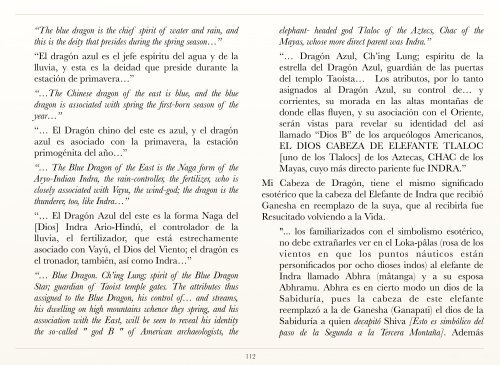Ganesha-El-Dios-de-la-Sabiduria-Segunda-Parte-y-la-Iniciacion-del-Dragon
Ganesha-El-Dios-de-la-Sabiduria-Segunda-Parte-y-la-Iniciacion-del-Dragon
Ganesha-El-Dios-de-la-Sabiduria-Segunda-Parte-y-la-Iniciacion-del-Dragon
Create successful ePaper yourself
Turn your PDF publications into a flip-book with our unique Google optimized e-Paper software.
“The blue dragon is the chief spirit of water and rain, and<br />
this is the <strong>de</strong>ity that presi<strong>de</strong>s during the spring season…”<br />
“<strong>El</strong> dragón azul es el jefe espíritu <strong>de</strong>l agua y <strong>de</strong> <strong>la</strong><br />
lluvia, y esta es <strong>la</strong> <strong>de</strong>idad que presi<strong>de</strong> durante <strong>la</strong><br />
estación <strong>de</strong> primavera…”<br />
“…The Chinese dragon of the east is blue, and the blue<br />
dragon is associated with spring the first-born season of the<br />
year…”<br />
“… <strong>El</strong> Dragón chino <strong>de</strong>l este es azul, y el dragón<br />
azul es asociado con <strong>la</strong> primavera, <strong>la</strong> estación<br />
primogénita <strong>de</strong>l año…”<br />
“… The Blue <strong>Dragon</strong> of the East is the Naga form of the<br />
Aryo-Indian Indra, the rain-controller, the fertilizer, who is<br />
closely associated with Vayu, the wind-god; the dragon is the<br />
thun<strong>de</strong>rer, too, like Indra…”<br />
“… <strong>El</strong> Dragón Azul <strong>de</strong>l este es <strong>la</strong> forma Naga <strong>de</strong>l<br />
[<strong>Dios</strong>] Indra Ario-Hindú, el contro<strong>la</strong>dor <strong>de</strong> <strong>la</strong><br />
lluvia, el fertilizador, que está estrechamente<br />
asociado con Vayú, el <strong>Dios</strong> <strong>de</strong>l Viento; el dragón es<br />
el tronador, también, así como Indra…”<br />
“… Blue <strong>Dragon</strong>. Ch’ing Lung; spirit of the Blue <strong>Dragon</strong><br />
Star; guardian of Taoist temple gates. The attributes thus<br />
assigned to the Blue <strong>Dragon</strong>, his control of… and streams,<br />
his dwelling on high mountains whence they spring, and his<br />
association with the East, will be seen to reveal his i<strong>de</strong>ntity<br />
the so-called " god B " of American archaeologists, the<br />
elephant- hea<strong>de</strong>d god T<strong>la</strong>loc of the Aztecs, Chac of the<br />
Mayas, whose more direct parent was Indra.”<br />
“… Dragón Azul, Ch’ing Lung; espíritu <strong>de</strong> <strong>la</strong><br />
estrel<strong>la</strong> <strong>de</strong>l Dragón Azul, guardián <strong>de</strong> <strong>la</strong>s puertas<br />
<strong>de</strong>l templo Taoísta… Los atributos, por lo tanto<br />
asignados al Dragón Azul, su control <strong>de</strong>… y<br />
corrientes, su morada en <strong>la</strong>s altas montañas <strong>de</strong><br />
don<strong>de</strong> el<strong>la</strong>s fluyen, y su asociación con el Oriente,<br />
serán vistas para reve<strong>la</strong>r su i<strong>de</strong>ntidad <strong>de</strong>l así<br />
l<strong>la</strong>mado “<strong>Dios</strong> B” <strong>de</strong> los arqueólogos Americanos,<br />
EL DIOS CABEZA DE ELEFANTE TLALOC<br />
[uno <strong>de</strong> los T<strong>la</strong>locs] <strong>de</strong> los Aztecas, CHAC <strong>de</strong> los<br />
Mayas, cuyo más directo pariente fue INDRA.”<br />
Mi Cabeza <strong>de</strong> Dragón, tiene el mismo significado<br />
esotérico que <strong>la</strong> cabeza <strong>de</strong>l <strong>El</strong>efante <strong>de</strong> Indra que recibió<br />
<strong>Ganesha</strong> en reemp<strong>la</strong>zo <strong>de</strong> <strong>la</strong> suya, que al recibir<strong>la</strong> fue<br />
Resucitado volviendo a <strong>la</strong> Vida.<br />
"... los familiarizados con el simbolismo esotérico,<br />
no <strong>de</strong>be extrañarles ver en el Loka-pâ<strong>la</strong>s (rosa <strong>de</strong> los<br />
vientos en que los puntos náuticos están<br />
personificados por ocho dioses indos) al elefante <strong>de</strong><br />
Indra l<strong>la</strong>mado Abhra (mâtanga) y a su esposa<br />
Abhramu. Abhra es en cierto modo un dios <strong>de</strong> <strong>la</strong><br />
Sabiduría, pues <strong>la</strong> cabeza <strong>de</strong> este elefante<br />
reemp<strong>la</strong>zó a <strong>la</strong> <strong>de</strong> <strong>Ganesha</strong> (Ganapati) el dios <strong>de</strong> <strong>la</strong><br />
Sabiduría a quien <strong>de</strong>capitó Shiva [Esto es simbólico <strong>de</strong>l<br />
paso <strong>de</strong> <strong>la</strong> <strong>Segunda</strong> a <strong>la</strong> Tercera Montaña]. A<strong>de</strong>más<br />
112



